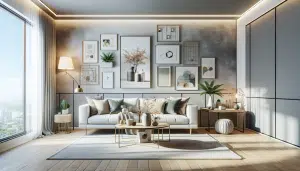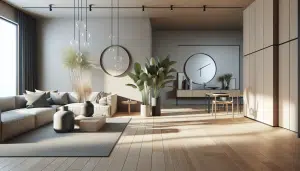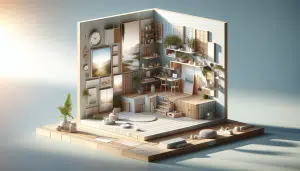Minimalist Living Spaces That Inspire You to Declutter
Lily Carter October 22, 2025
Discover how minimalist living spaces help you feel lighter, calmer, and more focused. This article guides you through practical decluttering tips, benefits of simplicity, and design strategies that make everyday life easier to manage while keeping your home stylish.
Understanding Minimalism and Its Appeal
Minimalism has rapidly become a guiding philosophy for those seeking balance in their daily lives. This approach isn’t just about owning fewer possessions. It’s rooted in the idea that simplicity promotes clarity, peace, and happiness. Minimalist living spaces embrace open areas, neutral colors, and intentional décor, helping to alleviate stress and reduce the chaos that often comes with excess clutter. People gravitate toward minimalism to experience a refreshing sense of order. As distractions are removed, the home becomes a sanctuary where priorities become clearer. Minimalism encourages thoughtful decision-making when it comes to possessions. Instead of accumulating more, this lifestyle is about cherishing what matters most and letting go of the rest. For many, transforming to a minimalist space marks the beginning of deeper changes in mindset and habits. These benefits are not just theoretical—studies highlight that people in decluttered spaces tend to report greater well-being and productivity (Source: https://www.apa.org/news/press/releases/2017/06/clutter-affects-well-being).
What gives minimalist homes their distinctive charm? The style focuses on functional beauty. By stripping away non-essentials, rooms reveal their true purpose. Natural light floods open layouts, helping to boost energy during the day. Soft texture—think wood, stone, or linen—creates warmth and comfort, even in the simplest settings. Rather than appearing cold, minimalist spaces can feel surprisingly inviting. The key lies in balancing simplicity with personality. Displaying a few meaningful items—a family photograph, a treasured piece of art, or a single statement plant—adds character without overwhelm. Minimalism encourages people to reevaluate relationships with belongings. With fewer choices to make, daily routines become smoother. The home feels less like a storage unit and more like a place to recharge.
Minimalism appeals to people from all walks of life, regardless of home size or budget. Even a small apartment can benefit from these principles. The secret is learning to prioritize what serves a purpose and brings joy. Modern design trends showcase minimalist living as both practical and aesthetically pleasing. Many rental and urban spaces use these strategies to make even modest homes feel airy and sophisticated. As clutter clears, creativity flourishes. The less-is-more philosophy gives room for new experiences and memories, rather than material distractions. Overall, minimalist living spaces inspire mindful consumption—an approach that resonates deeply in a fast-paced, distraction-filled world.
Benefits of Decluttering Your Space
Decluttering is much more than simply throwing things away. It’s a process that creates mental clarity, reduces stress, and sets a positive tone for everything else in life. Living in a cluttered environment can make daily tasks difficult and overwhelming. Many report that tackling mess in their homes provides a renewed sense of control. Minimalist living removes the visual noise that distracts and drains. Focusing on core essentials leaves room to breathe—physically and emotionally. Several experts link tidy spaces with better focus, more creative thinking, and healthier routines (Source: https://health.clevelandclinic.org/clutter-effects).
Many people feel attached to items that no longer serve a purpose. Over time, these accumulate until the home feels crowded or chaotic. A conscious effort to pare down can spark emotional relief. As old belongings exit, new habits can form. You may find yourself more inclined to clean, more willing to invite friends over, or more able to unwind after work. Freeing up space often leads to unexpected energy. It also sets a healthy example for children or roommates. When household members see clutter as a problem with a solution, teamwork thrives and maintenance becomes easier for everyone.
There are even financial perks to decluttering. Selling, donating, or repurposing unused possessions can add value in practical ways. People save on cleaning supplies, storage containers, or even the need for larger homes. Learning to live with less reduces shopping impulses, allowing you to direct money toward experiences or investments that matter. Minimalist spaces are easier to clean, reducing time spent on chores. Overall, the shift to a decluttered lifestyle can lead to more freedom and peace of mind. Whether you start with a single drawer or a whole room, the ripple effects support better sleep, improved relationships, and greater satisfaction with your environment.
How to Start Creating a Minimalist Home
Beginning the minimalist journey can feel challenging. The first step is always the hardest! Experts suggest starting small. Choose one area—perhaps a countertop or junk drawer—and clear it completely. Decide which items are truly needed or bring you happiness. Everything else can be sorted into “donate,” “trash,” or “storage” piles. As you practice, it becomes easier to make confident decisions about what stays. Consider your lifestyle and future needs at every step. Minimalism isn’t about deprivation—it’s about aligning your environment with your values. Setting realistic goals keeps overwhelm at bay (Source: https://www.nytimes.com/guides/smarterliving/how-to-declutter-your-home).
Once one area feels lighter, build momentum. Move methodically through spaces—bedroom, kitchen, living room, and beyond. Focus on surfaces first, then address hidden spots like closets or drawers. Minimalist living spaces thrive on clear counters, organized storage, and visible floors. Consider furniture that doubles as storage, or see-through organizers that make daily items easy to find. Labeling boxes, baskets, or bins improves the system. Some people track progress with before-and-after photos. Celebrating small wins helps to reinforce positive change. Don’t rush. Give yourself grace as habits shift over time.
Decluttering is rarely a one-time event. Maintenance is key. Designate a spot for daily essentials: mail, keys, electronics. Review possessions seasonally. Ask yourself, “Did I use this in the past year?” If not, let it go. Encourage family members to participate by making decluttering a shared routine. Remember to appreciate the empty spaces left behind. Minimalism isn’t about filling every gap. Sometimes, it’s the empty areas that feel the most luxurious. Over weeks and months, you’ll notice a lighter atmosphere and deeper sense of accomplishment. Your home will reflect your best self.
Designing Your Home With Minimalism in Mind
A minimalist home doesn’t mean all white walls and plain furniture. In fact, a minimalist aesthetic can be expressive and warm. Embrace natural elements—soft wood, breathable fabrics, woven baskets. Use lighting wisely. Large windows and sheer curtains invite sunlight, expanding even the smallest rooms. Plants, simple artwork, or textured rugs add personality and coziness. When choosing color schemes, neutrals form a restful base. Accent with one or two hues that complement the existing palette. Opt for quality over quantity in every décor decision (Source: https://www.architecturaldigest.com/story/minimalist-home-design).
Arranging furniture with intention makes a space feel both elegant and useful. For city dwellers or those with limited square footage, multi-functional pieces are game-changers. Think beds with built-in storage, nesting coffee tables, or convertible desks. Streamline entertainment areas by mounting TVs on walls or grouping media in concealed cabinets. Floating shelves help display select objects without overwhelming the eye. Mirrors can visually expand space and reflect natural light. Minimalist spaces inspire a sense of calm by focusing the attention on what’s essential, so avoid overcrowding rooms with too much furniture or décor.
Don’t be afraid to let spaces “breathe.” Open floor plans and uncluttered pathways promote flow and relaxation. If you love books, display them sparingly or use them as intentional accents. The real beauty in minimalist design is its adaptability. You can highlight favorite pieces by making them the center of attention, such as a statement chair or artwork. Over time, you’ll discover the style that best fits your needs and personality. Whether cozy, modern, or traditional, the principles of minimalist living apply across every taste and budget. The benefits compound with every design choice that centers function and joy.
Embracing a Minimalist Lifestyle Beyond Your Home
Minimalism extends far beyond what’s inside your four walls. Many people find that as their physical space becomes lighter, their habits change naturally. With fewer distractions at home, it’s easier to focus on meaningful activities—enjoying hobbies, connecting with loved ones, or pursuing new goals. Shoppers report reduced impulse spending. This opens up time and resources for learning, travel, or wellness. Minimalism is as much about mindset as it is about tidy shelves (Source: https://www.thesimplicityhabit.com/minimalism-benefits-how-to-get-started/).
Technology can help simplify routines, too. Smart storage solutions and digital organization tools make paperwork, scheduling, and reminders easier to handle. Unsubscribing from promotional emails or digital clutter also supports mental well-being. Minimalism in the digital realm frees attention for screen-free living. People often notice improved mood and focus after paring down phone notifications or social media use. Fewer digital distractions equal more time to spend in the present moment, which is a core value of the minimalist philosophy.
Relationships often benefit from the shift. Focusing on quality, not quantity, helps nurture meaningful connections. Minimalism reminds us to prioritize what counts, both in objects and social circles. Many describe a deeper appreciation for friendships, community involvement, and new experiences. By freeing yourself from excess, you create space—not just in your home, but in your routine, values, and dreams. Every step toward minimalism offers another chance to live with intention and satisfaction. And that sense of purpose invigorates all areas of life.
Common Challenges and How to Overcome Them
Shifting to a minimalist lifestyle can present obstacles. Sentimental attachment to objects is one of the most frequent hurdles. It can be difficult to part with items that hold memories or represent important events. One solution is to photograph meaningful possessions before letting them go. Create a digital scrapbook or journal to remember favorite stories. This balances emotional needs with the desire for a lighter living space. Practice gratitude for what the items brought you, then pass them along so others can benefit (Source: https://www.verywellmind.com/minimalism-benefits-4777942).
Another common pitfall is the frustration that comes from slow progress. Decluttering takes time—especially for busy households or shared spaces. Set realistic, achievable milestones. Celebrate small successes. If other members in the household are resistant, lead by example and invite participation without pressure. It’s important to remember there is no single perfect version of minimalism. Tailor the process to fit your own life and values. Over time, the small choices add up to big change.
Fear of needing something later can hinder decisions. Many hold onto obscure tools, clothes that no longer fit, or stacks of paperwork “just in case.” Consider the cost of storing versus replacing. Would it be difficult or expensive to reacquire? If not, trust the process and let items go. Create a donation box or “maybe pile” to revisit at the end of the month. Minimalism is a journey, not a race. Give yourself kindness as you experiment, learn, and adapt. Every effort counts toward a calmer, more enriching daily environment.
References
1. American Psychological Association. (2017). Clutter affects well-being. Retrieved from https://www.apa.org/news/press/releases/2017/06/clutter-affects-well-being
2. Cleveland Clinic. (2022). How Clutter Affects Your Health. Retrieved from https://health.clevelandclinic.org/clutter-effects
3. New York Times. (n.d.). How to Declutter Your Home. Retrieved from https://www.nytimes.com/guides/smarterliving/how-to-declutter-your-home
4. Architectural Digest. (n.d.). Minimalist Home Design. Retrieved from https://www.architecturaldigest.com/story/minimalist-home-design
5. The Simplicity Habit. (n.d.). Minimalism Benefits & How to Get Started. Retrieved from https://www.thesimplicityhabit.com/minimalism-benefits-how-to-get-started/
6. Verywell Mind. (2021). The Benefits of Minimalism. Retrieved from https://www.verywellmind.com/minimalism-benefits-4777942







